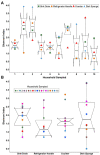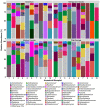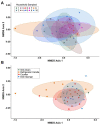Evaluation of the kitchen microbiome and food safety behaviors of predominantly low-income families
- PMID: 36246211
- PMCID: PMC9557297
- DOI: 10.3389/fmicb.2022.987925
Evaluation of the kitchen microbiome and food safety behaviors of predominantly low-income families
Abstract
Bacterial pathogens in the domestic environment present a risk to residents, particularly among susceptible populations. However, the impact of consumer demographic characteristics and food handling methods on kitchen microbiomes is not fully understood. The domestic kitchen bacterial communities of ten predominantly low-income families in Houston, TX, were assessed in conjunction with a cross-sectional food safety survey to evaluate differences in household and surface-specific microbiomes and bacterial foodborne pathogen presence. Three kitchen surfaces within each household, including the sink drain, the refrigerator handle, and the counter, were environmentally sampled and metataxonomically evaluated via targeted 16S rRNA sequencing. Disposable dish sponges were also acquired and examined. Results indicated that alpha diversity did not vary by the households, sampling locations, or demographic characteristics evaluated. Significant differences in beta diversity were observed among the bacterial communities of five pairs of households and between refrigerator handle and disposable dish sponge microbiomes. A total of 89 unique bacterial foodborne pathogens were identified across surface types. Each household contained at least one contaminated surface, and the most common bacterial foodborne pathogens identified were Escherichia coli, Staphylococcus aureus, and Klebsiella pneumoniae. All parents reported washing their hands before meal preparation, washing fresh fruits and vegetables, and washing cutting boards with soap after use to prepare raw animal proteins. Gaps in food safety behaviors identified included a lack of serious concern for food contamination with germs and inappropriate handwashing, food handling, and cleaning behaviors. The number of unique bacterial foodborne pathogens identified within households was significantly higher among households whose respondent parent reported that they did not consider food contamination with germs to be a serious food safety problem (median: 41.0 species) compared to households whose respondent parent did consider food contamination to be a serious food safety problem (median: 3.0 species; p value = 0.0218). These results demonstrate that domestic kitchen taxonomic abundance profiles vary according to household and surface type. Data suggest that low-income consumers may be at risk of foodborne pathogen exposure from contaminated home kitchen surfaces, and that food safety attitudes may directly contribute to this hazard.
Keywords: consumer behavior; demographic disparities; diarrheal disease; food safety; foodborne illness; indoor built environment; metataxonomics; sanitation.
Copyright © 2022 Carstens, Salazar, Sharma, Chan and Darkoh.
Conflict of interest statement
The authors declare that the research was conducted in the absence of any commercial or financial relationships that could be construed as a potential conflict of interest.
Figures





Similar articles
-
Food Safety Attitudes, Behaviors, and Hygiene Measures among Predominantly Low-Income Parents in Houston, Texas.J Food Prot. 2022 Dec 1;85(12):1745-1755. doi: 10.4315/JFP-22-179. J Food Prot. 2022. PMID: 36048912
-
Sexual Harassment and Prevention Training.2024 Mar 29. In: StatPearls [Internet]. Treasure Island (FL): StatPearls Publishing; 2025 Jan–. 2024 Mar 29. In: StatPearls [Internet]. Treasure Island (FL): StatPearls Publishing; 2025 Jan–. PMID: 36508513 Free Books & Documents.
-
Systemic pharmacological treatments for chronic plaque psoriasis: a network meta-analysis.Cochrane Database Syst Rev. 2021 Apr 19;4(4):CD011535. doi: 10.1002/14651858.CD011535.pub4. Cochrane Database Syst Rev. 2021. Update in: Cochrane Database Syst Rev. 2022 May 23;5:CD011535. doi: 10.1002/14651858.CD011535.pub5. PMID: 33871055 Free PMC article. Updated.
-
Systemic pharmacological treatments for chronic plaque psoriasis: a network meta-analysis.Cochrane Database Syst Rev. 2017 Dec 22;12(12):CD011535. doi: 10.1002/14651858.CD011535.pub2. Cochrane Database Syst Rev. 2017. Update in: Cochrane Database Syst Rev. 2020 Jan 9;1:CD011535. doi: 10.1002/14651858.CD011535.pub3. PMID: 29271481 Free PMC article. Updated.
-
Behavioral interventions to reduce risk for sexual transmission of HIV among men who have sex with men.Cochrane Database Syst Rev. 2008 Jul 16;(3):CD001230. doi: 10.1002/14651858.CD001230.pub2. Cochrane Database Syst Rev. 2008. PMID: 18646068
Cited by
-
Mapping the Kitchen Microbiota in Five European Countries Reveals a Set of Core Bacteria across Countries, Kitchen Surfaces, and Cleaning Utensils.Appl Environ Microbiol. 2023 Jun 28;89(6):e0026723. doi: 10.1128/aem.00267-23. Epub 2023 May 31. Appl Environ Microbiol. 2023. PMID: 37255441 Free PMC article.
-
Viability discrimination of bacterial microbiomes in home kitchen dish sponges using propidium monoazide treatment.Environ Microbiol Rep. 2024 Oct;16(5):e70006. doi: 10.1111/1758-2229.70006. Environ Microbiol Rep. 2024. PMID: 39440931 Free PMC article.
-
Citywide metagenomic surveillance of food centres reveals local microbial signatures and antibiotic resistance gene enrichment.NPJ Antimicrob Resist. 2025 Jul 8;3(1):63. doi: 10.1038/s44259-025-00132-0. NPJ Antimicrob Resist. 2025. PMID: 40629022 Free PMC article.
-
The indoors microbiome and human health.Nat Rev Microbiol. 2024 Dec;22(12):742-755. doi: 10.1038/s41579-024-01077-3. Epub 2024 Jul 19. Nat Rev Microbiol. 2024. PMID: 39030408 Review.
-
Biocontrol in built environments to reduce pathogen exposure and infection risk.ISME J. 2024 Jan 8;18(1):wrad024. doi: 10.1093/ismejo/wrad024. ISME J. 2024. PMID: 38365248 Free PMC article. Review.
References
-
- Borrusso P. A., Henley S., Quinlan J. J. (2015). Visual audit of food safety hazards present in homes in an urban environment. Food Prot. Trends 35, 290–301.
Grants and funding
LinkOut - more resources
Full Text Sources

